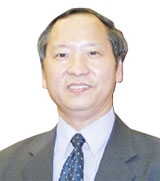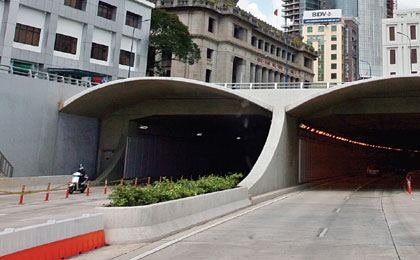ODA progress highlighted at CG Meeting
 The Vietnamese government has emphasised boosting ODA capital disbursement this year. How has this been done in the last five months?
The Vietnamese government has emphasised boosting ODA capital disbursement this year. How has this been done in the last five months?
Yes, Vietnam’s government promised donors that 2012 must see a breakthrough in ODA disbursement. The Ministry of Planning and Investment (MPI) has since early this year collaborated with other ministries, concerned state agencies, localities and donors to hold meetings to review the implementation of ODA-funded projects and programmes and promptly solve difficulties. Thereby, ODA disbursement in the last five months has increased 52 per cent on-year to $1.82 billion.
What challenges has Vietnam faced in ODA disbursement?
Though much progress has been made in mobilising, attracting, managing and using ODA, disbursement is still far from our expectations, especially for large-scale investment projects.
The slow ODA disbursement has resulted from both objective and subjective causes.
For example, Vietnam’s system of legal documents on ODA attraction, management and usage remains inconsistent and incompatible with international practices. This has caused difficulties to project implementation.

Specifically, as policies and regulations on capital construction are often changed, many projects have had their investment capital revised, while regulations on revising projects remain complicated.
Besides, though Vietnam and donors have made much progress in harmonising procedures, some differences remain. This is particularly so in bidding, site clearance, compensation and resettlement.
Moreover, it takes two or three years for preparing and implementing projects, from proposing ideas to signing an international treaty for the project. Thus projects often have their designs, technologies and investment capital revised, while site clearance costs also increase.
However, the biggest difficulty is site clearance. The main reasons behind the slowness in site clearance include different policies on land compensation and clearance and resettlement, localities’ unstable land use planning which has forced projects to be revised, and localities’ capital shortage for compensation, site clearance and resettlement.
Besides, the collaboration mechanism between ministries, concerned state agencies and localities involved in ODA-funded projects remains lax and ineffective, while localities’ organisation and management ability is limited.
What is your expectation of ODA for Vietnam, especially given the fact that it has just become a lower middle-income country?
In the development cooperation sector, foreign development partners will change their assistance policies for Vietnam, in a manner to be suitable to the conditions of the country which has been listed as a lower middle-income country. Accordingly, the characteristics, scale and conditions in ODA provision to Vietnam can be featured as follows.
Some bilateral donors will change the form of development cooperation with Vietnam to direct support for development of partnership arrangements such as inter-relationship between universities, research institutes and centres or organisations.
Some others will likely phase out their aid programmes for Vietnam in the coming years.
Most donors will adjust and change their assistance policies for Vietnam and thus ODA funds tend to drop and concessional loans gradually increase. This requires Vietnam to have proper approaches to the mobilisation of funds and to enhancing the effectiveness of these funds to satisfy the demand for development investment.
New approaches and aid modalities such as programme-based approaches, general budget support and targeted budget support will be applied more widely. Division of labour and complimentaries among development partners based on comparative advantages will be strongly promoted.
The private sector will be encouraged to join infrastructure development, especially in the form of public-private partnership. The participation of non-governmental organisations in the process of development will be promoted.
Some donors will provide ODA and concessional loans through multilateral programmes like HIV/AIDS prevention, climate change adaptation and mitigation, and regional cooperation activities under the framework of ASEAN and Greater Mekong Sub-region. These trends will continue to be strengthened and expanded in the coming year.
Thus, in mobilising ODA and concessional loans, we would need a flexible approach in which we will maximise the use of ODA loans with preferential conditions. Especially during 2011-2015, we must combine the non-refundable sums, ODA and concessional loans to “soften” loans.
The orientations for Vietnam’s use of ODA and concessional loans in the future should be as follows.
Non-refundable ODA will be used for poverty reduction, health care and education, institutional development and human resources, science, technique and technology transfer.
ODA funds will be focused into building infrastructure, social welfare works, and projects in the sectors in which capital cannot be directly recouped and comes from the state coffers.
Concessional loans will be earmarked for national key projects with capacity of re-payment, such as hydropower plants, expressways, metros, flyover railways in big cities, and communication systems.
What is your message to donors about Vietnam’s ever-increasing efficiency in ODA usage?
The government has been making great efforts in collaborating with donors to make its ODA policies better, in which procedures will be simplified and more harmonious to adapt to realities.
The government is implementing the Vietnam Partnership Document based on the Busan Partnership Document already adopted at the 4th High-level Forum on Aid Effectiveness in South Korea’s Busan city in December, 2011. I do believe that Vietnam’s attraction, management and use of ODA will become increasingly effective in the coming time.
Vietnam’s government highly values results produced from consultative group meetings and will together with donors ameliorate the quality and effectiveness in policy dialogue, via renewing the form and content of these meetings in the future.
We also would like to receive more support from donors to help Vietnam with its socio-economic development, poverty reduction and coping with climate change, especially via dialogues with Vietnam’s central provinces at this mid-term CG meeting in central Quang Tri province.
What the stars mean:
★ Poor ★ ★ Promising ★★★ Good ★★★★ Very good ★★★★★ Exceptional
Related Contents
Latest News
More News
- Vietnam eases policy approval requirements, simplifies foreign and outbound investments (December 11, 2025 | 17:53)
- Unpacking new momentum in Vietnam’s M&A market (December 10, 2025 | 09:59)
- Forum honours outstanding M&A deals, strategies, and advisory firms (December 09, 2025 | 18:22)
- Vietnam enters defining phase of M&A growth (December 09, 2025 | 17:00)
- Vietnam’s M&A market opens new opportunities amid strong economic momentum (December 09, 2025 | 15:00)
- Vietnam M&A Forum 2025: new position, new momentum (December 09, 2025 | 14:30)
- FDI in Vietnam jumps on additional capital and share purchases (December 09, 2025 | 13:56)
- VIR gathers dealmakers for M&A forum (December 08, 2025 | 17:17)
- Vietnam steps up green transformation with strong policies and rising investment demand (December 06, 2025 | 12:07)
- Listed companies honoured for information transparency (December 06, 2025 | 11:59)

 Tag:
Tag:





















 Mobile Version
Mobile Version